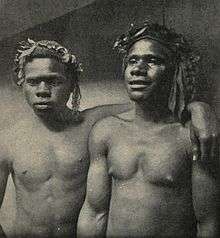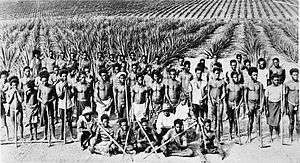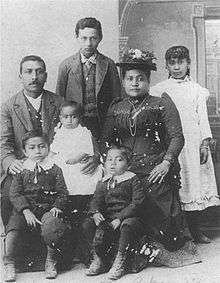Kanaka (Pacific Island worker)
Kanakas were workers from various Pacific Islands employed in British colonies, such as British Columbia (Canada), Fiji, Solomon Island, Vanuatu, Papua New Guinea and Queensland (Australia) in the 19th and early 20th centuries. They also worked in California and Chile (see Easter Island and Rapanui people as related subjects).

"Kanaka", originally referred only to native Hawaiians, from their own name for themselves, kānaka ʻōiwi or kānaka maoli, in the Hawaiʻian language. In the Americas in particular, native Hawaiians were the majority; but Kanakas in Australia were almost entirely Melanesian. In Australian English "kanaka" is now avoided outside of its historical context, as it has been used as an offensive term.[1]
Australia

According to the Macquarie Dictionary, the word "kanaka", which was once widely used in Australia, is now regarded in Australian English as an offensive term for a Pacific Islander.[1][2] Most "Kanakas" in Australia were people from Melanesia, rather than Polynesia. The descendants of 19th century immigrants to Australia from the Pacific Islands now generally refer to themselves as "South Sea Islanders", and this is also the term used in formal and official situations.
Most of the original labourers were recruited from the Solomon Islands, the New Hebrides (Vanuatu), and New Caledonia, though others were taken from the Loyalty Islands. Some were kidnapped ("blackbirded") or otherwise induced into long-term slavery or unfree labour.
The first shipload of 65 Melanesian labourers arrived in Boyd Town on 16 April 1847 on board the Velocity, a vessel under the command of Captain Kirsopp and chartered by Benjamin Boyd.[3] Boyd was a Scottish colonist who wanted cheap labourers to work at his expansive pastoral leaseholds in the colony of New South Wales. He financed two more procurements of South Sea Islanders, 70 of which arrived in Sydney in September 1847, and another 57 in October of that same year.[4][5] Many of these Islanders soon absconded from their workplaces and were observed starving and destitute on the streets of Sydney.[6] After the report of the alleged murder of the Native Chief of the Island of Rotumah in 1848, a closed-door enquiry was held, choosing not to take any action against Boyd or Kirsopp.[7] The experiment of exploiting Melanesian labour was discontinued in Australia until Robert Towns recommenced the practice in the early 1860s.
More than 60,000 Islanders had been brought to Australia after 1863, and about 10,000 were living in Queensland and northern New South Wales in 1901. The majority of those were repatriated by the Australian Government between 1906 and 1908, under the Pacific Island Labourers Act 1901,[8] legislation that was an essential part of the White Australia policy. Some were exempted on various grounds, including marriage to Australians.
Today, their descendants, and those of others who avoided deportation, form Australia's largest Melano-Polynesian ethnic group. Many Australian South Sea Islanders are also of mixed ancestry, including Aboriginal and Torres Strait Islanders, for whom they are often mistaken. As a consequence, Australian South Sea Islanders have faced forms of discrimination similar to Aboriginals and Torres Strait Islanders.
After 1994, the Australian South Sea Islander community was recognised as a unique minority group, following a report by the Australian Human Rights and Equal Opportunity Commission, which found they had become more disadvantaged than indigenous Australians.[9]
Canada

Canadian Kanakas were all Hawaiian in origin. They had been aboard the first exploration and trading ships to reach the Pacific Northwest Coast. There were cases of Kanakas jumping ship then living amongst various First Nations peoples. The first Kanakas to settle came from Fort Vancouver after clearing the original Fort Langley site and building the palisade (1827). They were often assigned to the fur brigades and Express of the fur companies and were a part of the life of company forts. A great many were contracted to the Hudson's Bay Company while some had arrived in the area as ship's hands. In other instances, they migrated north from California.
Many Kanaka men married First Nations women,[10] and their descendants can still be found in British Columbia and neighbouring parts of Canada, and the United States (particularly in the states of Washington and Oregon). Kanaka Creek, British Columbia, was a community of mixed Hawaiian-First families established across the Fraser River from Fort Langley in the 1830s, which remains on the map today.
Kanakas were active in both the California Gold Rush, and in the Fraser Canyon Gold Rush and other rushes. Kanaka Bar, British Columbia gets its name from claims staked and worked by Kanakas who had previously worked for the fur company (which today is a First Nations community of the Nlaka'pamux people).
There were no negative connotations in the use of Kanaka in British Columbian and Californian English of the time, and in its most usual sense today, it denotes someone of Hawaiian ethnic inheritance, without any pejorative meaning.
One linguist holds that Canuck, a nickname for Canadians, is derived from the Hawaiian Kanaka.[11]
United States
The first native workers from the Hawaiian Islands (called the "Sandwich Islands" at the time) arrived on the Tonquin in 1811 to clear the site and help build Fort Astoria, as undertaken by the Pacific Fur Company. Nearly 12 Kanakas or a third of the workforce wintered over among "Astorians". Kanakas built Fort Elizabeth on the island of Kauaʻi in Hawaiʻi for the Russian American Company in 1817, with others to follow.
By the 1820s, Kanakas were employed in the kitchen and other skilled trades by the Hudson's Bay Company at Fort Vancouver, mostly living south and west of the main palisade in an area known as "Kanaka Village." Kanakas, employed in agriculture and ranching, were present in the mainland United States as early as 1834, primarily in California under Spanish colonial rule, and later under American company contracts. (Richard Henry Dana refers often to Kanaka workers and sailors on the Californian coast in his book Two Years Before the Mast).
The migration of Kanakas peaked between 1900 and 1930, and most of their families soon blended by intermarriage into the Chinese, Filipino, and more numerous Mexican populations with whom they came in contact. At one point, Native Hawaiians harvested sugar beets and picked apples in the states of Washington and Oregon.
The Kanakas have left a legacy in Oregon place names, such as Kanaka Flat in Jacksonville, the Owyhee River in southeastern Oregon (Owyhee is an archaic spelling of Hawaii)[12][13] and the Kanaka Gulch.[14]
See also
| Wikisource has the text of the 1911 Encyclopædia Britannica article Kanaka. |
References
- Macquarie Dictionary (Fourth Edition), 2005, p. 774
- "Kanaka dictionary definition - Kanaka defined". www.yourdictionary.com.
- "EXPORTS". Sydney Chronicle. 4 (370). New South Wales, Australia. 21 April 1847. p. 2. Retrieved 1 May 2019 – via National Library of Australia.
- "SYDNEY NEWS". The Port Phillip Patriot and Morning Advertiser. X (1, 446). Victoria, Australia. 1 October 1847. p. 2. Retrieved 1 May 2019 – via National Library of Australia.
- "Shipping intelligence". The Australian. 22 October 1847. p. 2. Retrieved 1 May 2019 – via National Library of Australia.
- "The South Australian Register. ADELAIDE: SATURDAY, DECEMBER 11,1847". South Australian Register. XI (790). South Australia. 11 December 1847. p. 2. Retrieved 1 May 2019 – via National Library of Australia.
- "THE ALLEGED MURDER AT ROTUMAH". Bell's Life In Sydney And Sporting Reviewer. IV (153). New South Wales, Australia. 1 July 1848. p. 2. Retrieved 1 May 2019 – via National Library of Australia.
- "Pacific Island Labourers Act 1901 (Cth)". Documenting a Democracy. National Archives of Australia. Archived from the original on 26 October 2009. Retrieved 17 January 2019.
- "Recognition for Australian South Sea Islanders". Queensland Museum. Retrieved 5 May 2017.
- Koppel, Tom, 1995 Kanaka: The Untold Story of Hawaiian Pioneers in British Columbia and Pacific Northwest p 2
- Allen, Irving Lewis, 1990. Unkind Words: Ethnic Labeling from Redskin to WASP, pp 59, 61–62. New York: Bergin & Garvey. ISBN 0-89789-217-8.
- Rabun, Sheila J. (1 June 2011). "Aloha, Oregon! Hawaiians in Northwest History". Oregon Digital Newspaper Program. Retrieved 16 February 2016.
- Boom, Tony (28 April 2009). "The Hawaiians of Kanaka Flat". Mail Tribune. Medford, OR. Retrieved 16 February 2016.
- "Jackson County Place Names Database". Jackson County Genealogy Library. Archived from the original on 4 October 2018. Retrieved 29 May 2019.
Further reading
- Affeldt, Stefanie: Consuming Whiteness. Australian Racism and the ‘White Sugar’ Campaign. Lit-Verlag, Münster 2014, pp. 152–188
- Barman, Jean, 2006. "Leaving Paradise: Indigenous Hawaiians in the Pacific Northwest", University of Hawaii Press, 513pp. ISBN 0-8248-2549-7
- Di Giorgio, Wladimir, 2009. "Francs et Kanaks". rés. n°5195 A.P.E/Ctésia
- Graves, Adrian, 1983. "Truck and Gifts: Melanesian Immigrants and the Trade Box System in Colonial Queensland", in: Past & Present (no. 101, 1983)
- Koppel, Tom, 1995. Kanaka, The Untold Story of Hawaiian Pioneers in British Columbia and the Pacific Northwest, Whitecap Books, Vancouver
- Lane, M. Melia, 1985. "Migration of Hawaiians to Coastal B.C., 1810–1869." Master's Thesis, University of Hawaii, Honolulu
- Twain, Mark, 1897. "Following the Equator, A Journey Around the World", chapters V and VI.